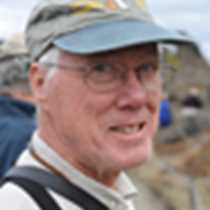Sitka, Alaska
Early this morning we turned from Chatham Strait into Peril Strait, the narrow channel between Baranof and Chichagof Islands. Our destination: Sitka, the capital of Russian America. The passage through Peril, Neva, and Olga Straits is too small for larger ships, particularly the constriction at Sergius Narrows where tidal water poured in at six knots. We shared our passage only with fishing boats, humpback whales, and hordes of bald eagles – all exploiting the resources of the Alaskan seas. In Salisbury Sound, looking out at the open Pacific Ocean, we found this troller pulling long lines of baited hooks past a feeding humpback. They are not competitors, for the troller seeks salmon returning from the open seas to spawn while the whale, only recently returned from its winter in Hawaii, gulps mouthfuls of smaller fish to rebuild its layer of blubber.
The Alaskan fishing industry has long been known (quite correctly!) for bringing the highest quality, wild-caught salmon to the world markets – kings, coho, sockeye, and pinks. Competition from farm-raised salmon, inconsistent catches, and conflicts between subsistence and commercial users have caused problems in marketing and management, but fishing remain an important part of the Alaskan economy and tradition, especially in the coastal towns and villages of the southeast.
Following our visit to Sitka we took advantage of relatively calm conditions to visit the offshore island of Saint Lazario, a lava island created by a past eruption of Mount Edgecumb volcano. It is home to breeding seabirds – murres, tufted puffins, two species of storm petrel, and, tonight, a peregrine falcon. We enjoyed Zodiac cruises around the island in the fading light (it was, after all, 10:00 pm!)
Early this morning we turned from Chatham Strait into Peril Strait, the narrow channel between Baranof and Chichagof Islands. Our destination: Sitka, the capital of Russian America. The passage through Peril, Neva, and Olga Straits is too small for larger ships, particularly the constriction at Sergius Narrows where tidal water poured in at six knots. We shared our passage only with fishing boats, humpback whales, and hordes of bald eagles – all exploiting the resources of the Alaskan seas. In Salisbury Sound, looking out at the open Pacific Ocean, we found this troller pulling long lines of baited hooks past a feeding humpback. They are not competitors, for the troller seeks salmon returning from the open seas to spawn while the whale, only recently returned from its winter in Hawaii, gulps mouthfuls of smaller fish to rebuild its layer of blubber.
The Alaskan fishing industry has long been known (quite correctly!) for bringing the highest quality, wild-caught salmon to the world markets – kings, coho, sockeye, and pinks. Competition from farm-raised salmon, inconsistent catches, and conflicts between subsistence and commercial users have caused problems in marketing and management, but fishing remain an important part of the Alaskan economy and tradition, especially in the coastal towns and villages of the southeast.
Following our visit to Sitka we took advantage of relatively calm conditions to visit the offshore island of Saint Lazario, a lava island created by a past eruption of Mount Edgecumb volcano. It is home to breeding seabirds – murres, tufted puffins, two species of storm petrel, and, tonight, a peregrine falcon. We enjoyed Zodiac cruises around the island in the fading light (it was, after all, 10:00 pm!)




